2046 wrote:Wrong.
If the Falcon example were the only example we had, one could seek assorted potential workarounds (read: evasions) of the statement's clear meaning, and the interior and exterior visuals.
(As it stands, I myself engage in a minor workaround inasmuch as I assume that Han's "range" refers to effective range, and not maximum range, giving SW the benefit of the doubt.)
However, we have numerous similar-range examples from SW (e.g. the atrocious AotC asteroid field chase, or innumerable short-range shots from RotJ and RotS), and no known counterexamples.
Therefore, it is perfectly valid to make use of this very specific statement for what it says . . . no failing of "a sense of honesty" required.
Okay, I think we could discuss about that in another thread as well. I still disagree with those ideas, but I'd like to streamline the thread back to its original topic.
I'll debate this range thing in another thread. Promise.
Why do you insist on misquotation and contradictions? The presence of a wall does not invalidate the canon fact that the docking bay consisted mostly of an entrance rampway and an enormous pit gouged from the rocky soil.
Misquotations? You should actually reread the extracts you provided, and compare that to the film!
Docking bays's floors don't appear to be below street level.
A gouge pit, by definition, points to a rough hole grossly dug in the ground, and
nothing else.
A structure which shares all the elements of a correctly built patio and not a pit dug clumsily inside the ground, which comprises a very flat floor, finely delimited, which is surrounded by erected walls of good finition, and accessed by automated doors, does not fit as something as rude and raw as a gouge pit.
Above all, seen from the outside, a docking bay just exactly looks like a solid and well finished building structure. It has sharp angles, indentations, gear-like protrusions surrounding the roof's exit, pipes and all that running through the walls, etc.
But more on the rather surprising "misquotations" claim;
Let's look at the extracts you provided:
Script:
"INTERIOR: MOS EISLEY SPACEPORT -- DOCKING BAY 94
Chewbacca leads the group into a giant dirt pit that is Docking
Bay 94. Resting in the middle of the huge hole is a large,
round, beat-up, pieced-together hunk of junk that could only
loosely be called a starship."
A giant dirt pit.
Completely inaccurate description of what the docking bay is in the film.
Novel:
"Docking bay ninety-four, Luke noted, was no different in appearance from a host of other grandiosely named docking bays scattered throughout Mos Eisley. It consisted mostly of an entrance rampway and an enormous pit gouged from the rocky soil. This served as clearance radii for the effects of the simple antigrav drive which boosted all spacecraft clear of the gravitational field of the planet.
The mathematics of spacedrive were simple enough even to Luke. Antigrav could operate only when there was a sufficient gravity well to push against-like that of a planet-whereas supralight travel could only take place when a ship was clear of that same gravity. Hence the necessity for the dual-drive system on any extrasystem craft.
The pit which formed docking bay ninety-four was as shabbily cut and run-down as the majority of Mos Eisley. Its sloping sides were crumbling in places instead of being smoothly fashioned as they were on more populous worlds. Luke felt it formed the perfect setting for the spacecraft Chewbacca was leading them toward."
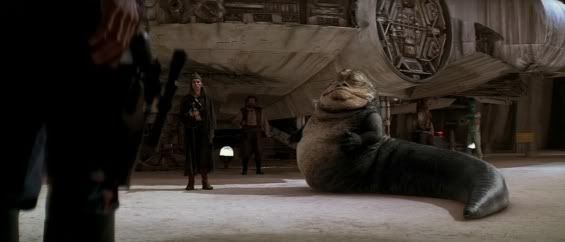

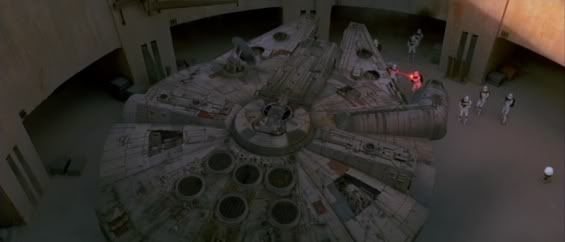

Obviously, "a giant dirt pit". Suer, Docking Bay 94 "consisted mostly of an entrance rampway and an enormous pit gouged from the rocky soil, [...]
shabbily cut and
run-down as the majority of Mos Eisley," which "
sloping sides were
crumbling in places instead of being
smoothly fashioned as they were on more populous worlds."

Note: for a city constantly beaten by sand storms and occupied by the galaxy's scums, its buildings hardly look like shabbily cut and run-down!
To sum up:
- It is not a giant dirt pit.
- It is not an enormous pit gouged from the rocky soil, shabbily cut and run-down.
- It has no sloping sides.
- It is not crumbling in pieces.
- The walls
are smoothly fashioned.
We can even spot dark traces running down the walls, proving the existence of other materials within the walls, either tubes, beams or bricks. This happens even to buildings made of solid and often reinforced bricks of concrete, where such "juices" transpire through the thin layers of paint and plasters stacked upon such walls, over the years.
We obviously see that both the script's and book's descriptions, globally agreeing with each other, do clearly
not correspond to the reality of the film.
What looks like a gouge pit is, for example, Owen's farm.
Ultimately, I don't even know why you brought this, but globally, this shows that there's a need for room for those
buildings.
Thus this point is completely covered.
IIIA. You still get it wrong. I say that in town shots show the existence of other tall buildings, not far from the two sister towers, yet they're no where to be seen on the wide shot.
Contradiction.
Other buildings of similar height to the two towers of the wide shot (ignoring for the moment the suggestion that those are the two towers of the crane shot) are visible in the wide shot at various locations.
No, or point out their existence compared to in town shots please.
For example, try to point out:
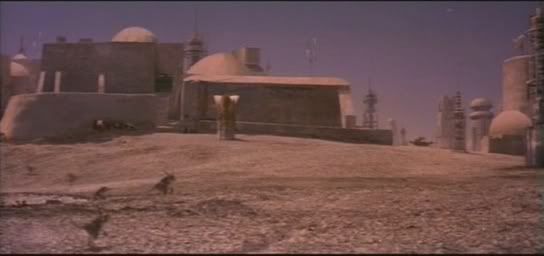
- the whitish building seen in the distant background, on the left of the landspeeder. If you consider the the perspective lines by looking at the orientation of the TL tower's roof, the tower I'm pointing to would ought to be even significantly higher.
But let's look at more examples of particularily tall structures.
Please, look at the three buildings on this shot:
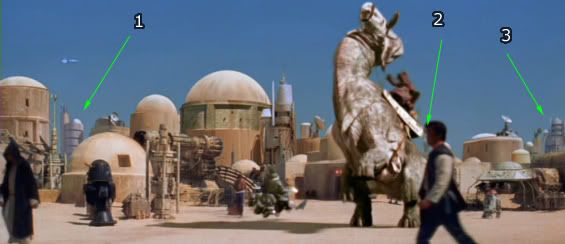
And now look at the tallest
and farthest buildings on the two following shots:
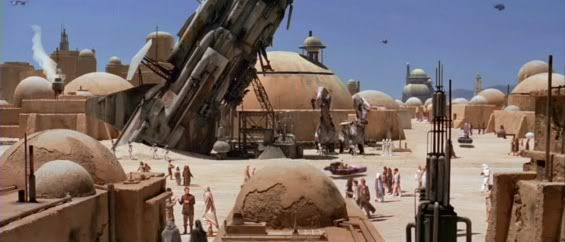

See how in the first cap, the buildings are largely more blue than the tall ones seen in the last two shots, even when they are far, actually?
The explanation is simple: they're even more distant. Far more distant. Yet, they are tall and large.
These are examples of taller buildings.
They would not be hard to spot at all on this picture:

Barring specific examples and specific reference points, then, you cannot claim contradiction. It would also be helpful if you could show that Mos Eisley is completely flat, though of course that won't be possible even given the entry CGI shot.
Solely based on
this,
this and
this shots, we can largely see that Mos Eisley is globally flat.
IIIB. There's no such a wide area where it should be. You're free to precisely point it out if you wish, to prove me wrong. Thus far, you stand corrected.
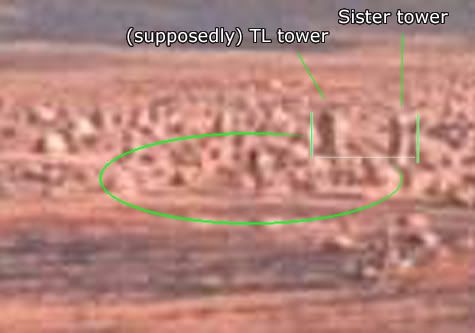
Look at the right-most portion of your circle. Just above that, your circle follows the road, assuming the two towers are the same. Just below that is wide open space. I can't tell if you reject the existence of that area or just that it could be the same one you're so on about, but either way your rejection confuses me.
What's to be confused about? My point was rather clear. The wide shot is inaccurate regarding the in town shots, and there's no way to know the size of the sort of structures seen on the wide shot besides looking for the size of towers in the in town shots.
Then, with those measures, you return to the wide shot angle, while it's vastly inaccurate regarding the in town shots. But that's not a bugger to you, you still go on and assume that your 25-30m tall structure corresponds to the taller structure seen on the wide shot.
Obviously, using a measurement from a set of in town shots, to a wide shot picture with proportions being different, and lacking several structures, is wrong.
It's like measuring the size of an ISD by measuring the size of a globe when the camera zooms on it while a starfighters passes by, which helps you define the globe's size. Then you use that measurement on a shot of the whole ISD where there's only one globe, and the supposedly same globe is half as big as the ISD. :/

As for the "road", it's another one of those funny artefacts to be seen I guess.
If you look at the TL tower in the in wide shot
zoomed in, you can see that the shadowed side is roughly as large as the one receiving light. So the corner edge is kinda facing us.
The "road" is going down at a 300° angle on the picture, passing between the two towers.
Compared to the picture just above, we can see that the orientation of the so "called road" is inconsistent. If it had been correctly represented, that road, on the wide shot, would have been going down at a 190-200° angle, from a point between the two towers.
IIIC. I reject is because it does not match the in town shots.
Only by your standard of contradiction, which is perilously low.
No. It's actually heavily documented, as you can see above.
I mean, seriously, do you wig out when TNG shows stock footage of the original ILM model and the "Bulldog" model in the same show, and declare those totally different Enterprises? Or do you simply completely reject the scenes showing one or the other because it is inaccurate compared to the other, in your view? Or better yet, when "Chain of Command" showed a Type-7 shuttle exterior and a Type-6 shuttle interior, how do you seek to handle that? Do you reject the exterior shots in their entirety, so that we cannot make any claims about the density of the soup they were flying through?
If you were going to make a measurement from one version of an object, and transpose that measurement to another variant of this "same" and glaringly wrong object, your whole measurement would not stand.
Like... measure the size of a bridge's window on a close shot, and then use that size window's size on another wide shot, which shows the bridge and the whole ship, yet a shot which has been proven contradictory towards the former close shot you used, saying for example that the "bridge size/window size" was largely different, this would be flawed and unreliable.
See the ISD globe example.
No, your personal interpretation of the "shining hairlines" concept is flawed. That's all.
Of course, because it just makes much more sense to actually point to something that's not shiny, and not hairline looking, and would not be seen from the surface, despite your claims.
Right.
II. What you're point out is that just basically, everybody disagrees on the definition and scope of villages, towns and cities.
Therefore there's no point arguing on this and trying to form an argument, since no one has the same definition of even a low standard for each type of somehow urban agglomeration.
Concession accepted, then.
If you want to consider that a concession, then fine. It's just as much a concession on both sides then, since you precisely point to the evidence that villages and towns can be of any sizes, constitutions and dimensions, but you consider that you can decide which is fine and which is not to define a town.
IV. That blackdrop enhancement argument is reasonable. You just have to look at the film to get plenty of shots stacked upon blackdrop
Those are few and far between, inasmuch as the true black of space is concerned. You can see, in the pic of mine you use as reference for the idea that we can't see bolts mere kilometers distant, that the black ain't so black.
We have shots where the camera is looking at the stars, with the planet out of screen, and often below the camera.
Even then, the bolts are barely visible.
People on the ground have zero chance to spot those bolts.
I do not reject the idea that, in theory, the heavier turbolaser would probably be the only one your average Joe could spot from the surface.
Then why all the squabble? We are directly told that folks could see bolts or collections of bolts between ships. Ergo, they can, and so if you agree that only the larger bolts would be visible then you have just agreed with me, and so your complaints are nullified.
I reject it because you can barely see even the heavier shots, and they become too faint to be seen a very few km away, and they're certainly
not bright enough to pose a glossy metal plates reflecting enough sunlight so that someone on the surface would seem them through the polluted atmoshpere, clouds and citylight perturbation.
We should drop that point. We're obviously never going to agree on that either, so meh.










